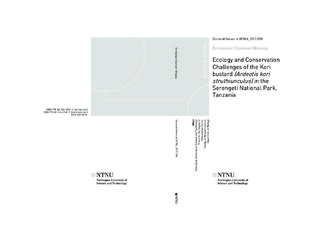| dc.contributor.advisor | Røskaft, Eivin | |
| dc.contributor.advisor | Bevanger, Kjetil | |
| dc.contributor.author | Mmassy, Emmanuel Clamsen | |
| dc.date.accessioned | 2017-09-15T13:40:22Z | |
| dc.date.available | 2017-09-15T13:40:22Z | |
| dc.date.issued | 2017 | |
| dc.identifier.isbn | 978-82-326-2549-9 | |
| dc.identifier.issn | 1503-8181 | |
| dc.identifier.uri | http://hdl.handle.net/11250/2454889 | |
| dc.description.abstract | The study focused on the ecology and conservation challenges of the Kori bustard in the Serengeti National Park. The main objectives of the study was to determine the factors that affect local ecological knowledge and perceived threats, density and occurrence, breeding ecology, seasonal migration and resource selection of the Kori bustard. The hypotheses were that, local people adjacent to the Serengeti National Park have good knowledge of ecology and the threats facing the Kori bustard. The Kori bustard population density in the grass plain varies with season and with different habitats, the breeding of the Kori bustard is influenced by the habitat and season and lasts for several months; and 1) the home ranges of male Kori bustards are larger than the home ranges of females during the breeding season due to displaying behaviour; 2) the home ranges of male Kori bustards are smaller than the home ranges of females during the non-breeding season; 3) Kori bustards migrate seasonally between breeding and non-breeding habitats, with males migrating over longer distances than females; and 4) the habitat preferences of the Kori bustard are gender specific and differ across seasons in response to temporal resource requirements.
Overall, the results indicated that local people close to the park, including the Maasai tribe, had good knowledge regarding the identification of the Kori bustard. Generally, males from all surveyed tribes showed better ability of identifying the species than females. Knowledge varied among age groups while educated and non-educated people showed similar levels of species identification. The results indicated that the Kori bustard population is smaller than before and observation frequency was declining. Illegal offtake is indicated as the main threat to the species in the study villages.
The density of Kori bustard in the study area is approximately 1.3 birds per km2 and is highest in the green grass habitat and during the short dry season. Further, the study revealed that the breeding season starts with a courtship display that peaks during the short dry and short rain seasons, whereas nests and chicks peak during long rain season. The adult sex ratio was skewed in different seasons, with male biases during the long and short rain seasons and female skewed during long and short dry seasons. Finally the results showed that Kori bustards have distinct movement patterns related to the breeding (December-June) and non-breeding periods (July-November). Males Kori bustards had larger home range movements that females and preferred open grassland during breeding season and shrublands during non-breeding season, whereas females preferred to use closed grassland vegetation, especially treed grassland. This knowledge is important in future conservation of this vulnerable species. | nb_NO |
| dc.language.iso | eng | nb_NO |
| dc.publisher | NTNU | nb_NO |
| dc.relation.ispartofseries | Doctoral theses at NTNU;2017:238 | |
| dc.relation.haspart | Paper 1: Mmassy, Emmanuel Clamsen; Røskaft, Eivin. Factors affecting local ecological knowledge and perceived threats to the kori bustard (Ardeotis kori struthiunculus) in the Serengeti Ecosystem, Northern Tanzania. International Journal of Biodiversity and Conservation 2014 ;Volum 6. s. 459-467
http://dx.doi.org/10.5897/IJBC2014.0719
This article is published under the terms of the Creative Commons Attribution License 4.0 | nb_NO |
| dc.relation.haspart | Paper 2: Mmassy, Emmanuel Clamsen; Fyumagwa, Robert D.; Jackson, Craig Ryan; Bevanger, Kjetil Modolv; Røskaft, Eivin. Kori bustard (Ardeotis kori struthiunculus) conservation status in the Serengeti-Ngorongoro plains, northern Tanzania. African Journal of Ecology 2016
http://dx.doi.org/10.1111/aje.12351
© 2016 John Wiley & Sons Ltd | nb_NO |
| dc.relation.haspart | Paper 3: Breeding ecology of Kori Bustard Ardeotis kori strunthiunculus in the Serengeti Nation Park - Is not included due to copyright the final published version is available at http://dx.doi.org/10.2989/00306525.2017.1404502 | nb_NO |
| dc.relation.haspart | Paper 4: Seasonal migration and resource selection in the Kori bustard in the serngeti ecosystem - Is not included due to copyright | nb_NO |
| dc.title | Ecology and Conservation Challenges of the Kori bustard in the Serengeti National Park | nb_NO |
| dc.type | Doctoral thesis | nb_NO |
| dc.subject.nsi | VDP::Mathematics and natural science: 400::Basic biosciences: 470 | nb_NO |

